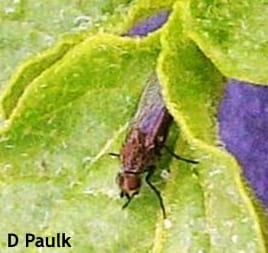Jerry Brust, IPM Vegetable Specialist, University of Maryland; jbrust@umd.edu
This spring has been pretty good for pests of early planted seeds and bulbs—the seed corn maggot Delia platura (SCM) and other seed maggots such as Cabbage maggot Delia radicum (it prefers to feed on cole crops) and Onion maggot Delia antiqua (it feeds on crops in the onion family). Seed corn maggot has the earliest peak flights in the spring and has a host range of over 30 crops, which include alliums and brassicas. This maggot also is often the cause of poor stands of peas. All species overwinter in the soil as a maggot inside a brown case. In March and April small, grayish-brown flies emerge (Fig. 1), usually early March for SCM and mid-April for cabbage and onion maggot. A good indicator for the first cabbage maggot peak flight and onion maggot beginning flights is the blooming of yellow rocket or wintercress. Adult flies are most active from 10 a.m.–2 p.m. and are inactive at night, in strong winds and when temperatures are below 50 °F or above 80 °F.
Female cabbage maggot flies seek out and lay eggs on the lower portions of stems of young host seedlings or in nearby cracks in the soil. Within a few days the eggs hatch and the tiny maggots burrow down to the roots and begin feeding. SCM eggs are oviposited in soils with decaying plant material or manure. The adults are also attracted to the organic media around the roots of transplants and germinating seeds. Maggots will move into small stems and move up the plant causing a swelling of the stem just above ground level, while also causing root collapse and decay. If these stems are split you will usually find the white cylindrical larvae (Figs. 2 and 3).

Figure 1. Adult seedcorn maggot fly
Soil temperatures three inches deep in the planting hole that are at or above 70o F reduce SCM egg laying and larval survival. If soil temperatures are above 70o F at planting but fall below this level for several days in a row SCM adults will begin to oviposit eggs at the base of transplants. When wilted transplants are inspected in the field, maggots are often not found (they have already pupated), but their tell-tale damage can be seen as a hollowed-out stem or root held together by a few strands of plant material.
Seed maggots cause damage by burrowing into seeds or cotyledons and hollowing them out. Although it can take 5 maggots per snap bean seed to cause significant damage, once the seed has been opened up by the maggots the seed becomes much more susceptible to invasion from
soil borne pathogens. The maggots also can burrow into the bulb or stem of transplants such as watermelon or cantaloupe as well as cole crops or garlic and onions.


Figures 2 and 3. Seedcorn maggots in stems of transplants
Management: The use of treated seed or in-row banding of an insecticide gives some control of SCM, however, once seed corn maggot damage is noticed, it is too late to apply control procedures. Thus, economic thresholds are not useful and all management options are preventative. Replacing the dead seedlings or transplants is the only solution after SCMs kill a plant. Wait at least 5 days if maggots are a quarter inch long; if they are smaller than that, wait 10 days to make sure they have pupated and cannot damage the new seeds or plants. Overcast wet conditions and fields with moist, heavy-textured soil usually have the worst problems. Avoid planting a crop following root crops or cole crops such as cabbage and cauliflower or after fall tomatoes. Later-season plantings may avoid the early season infestation of SCM. For crops like onions or garlic row covers can be used as soon as transplants are put in the field. Plants can remain covered until the ground warms. Diazinon as a broadcast application before planting can be used with some vegetables, as well as post planting options using applications of Malathion or pyrethroids (be sure to check the label for each crop and see the 2019 Commercial Vegetable Production Recommendations guide).
